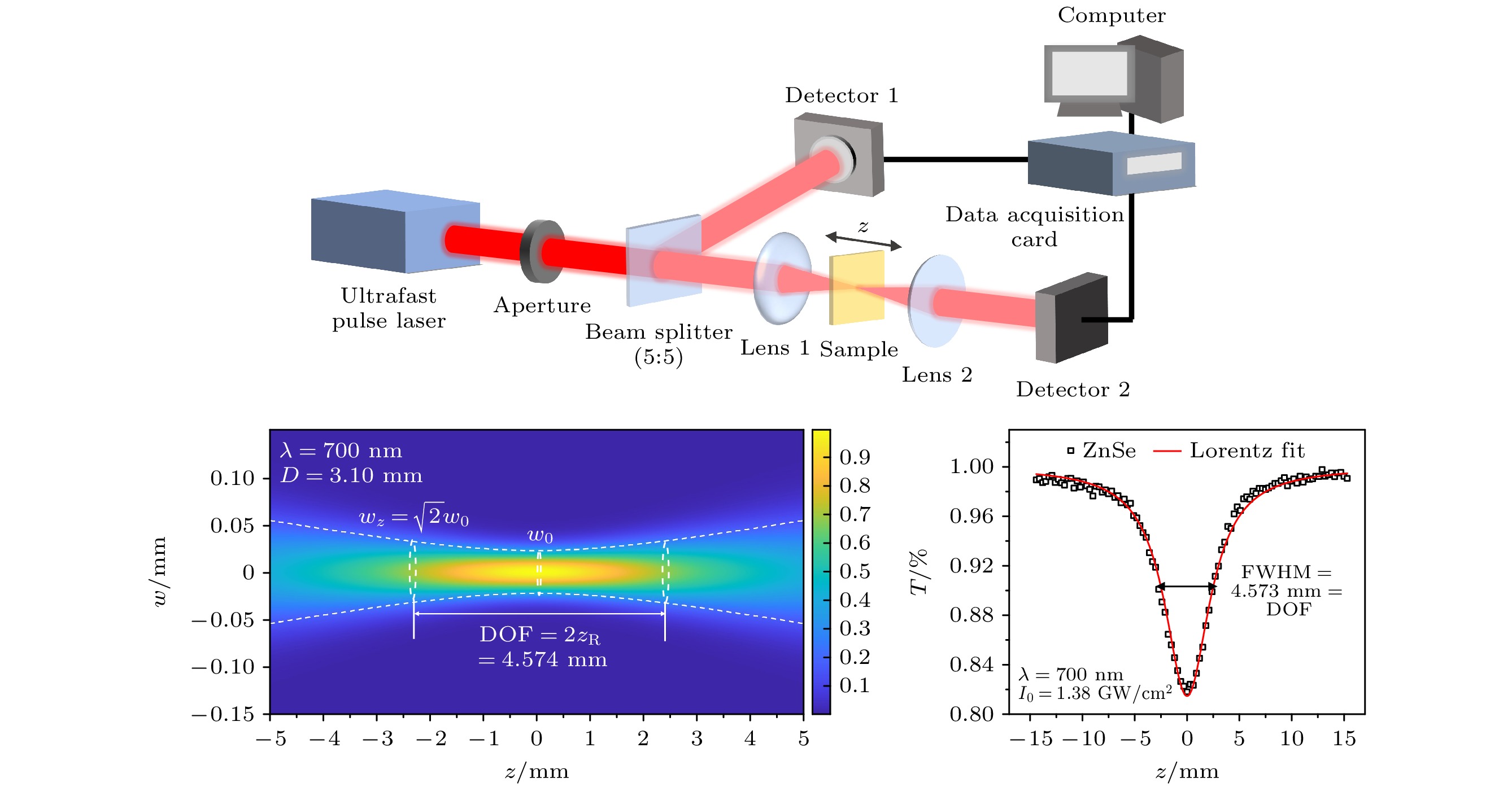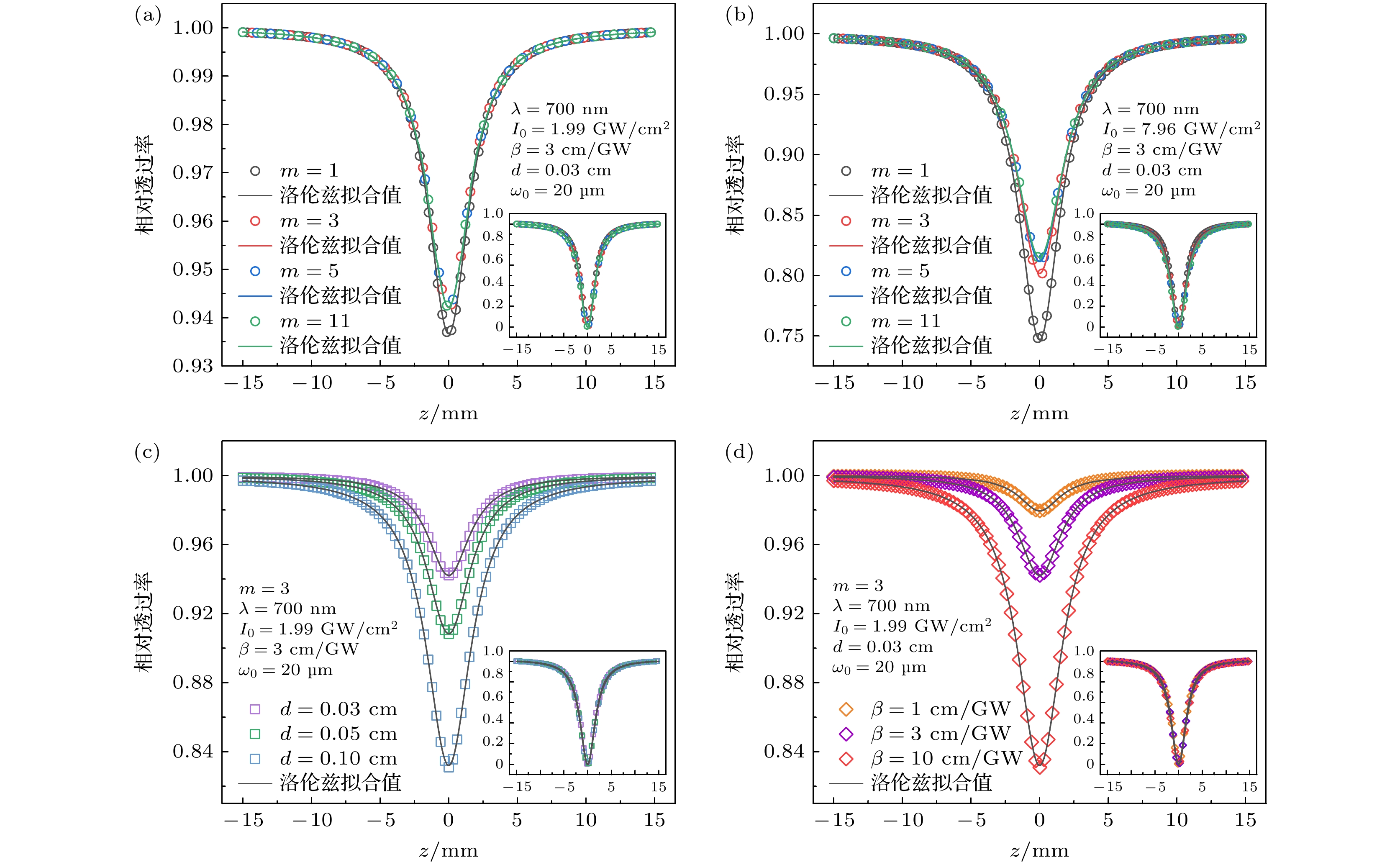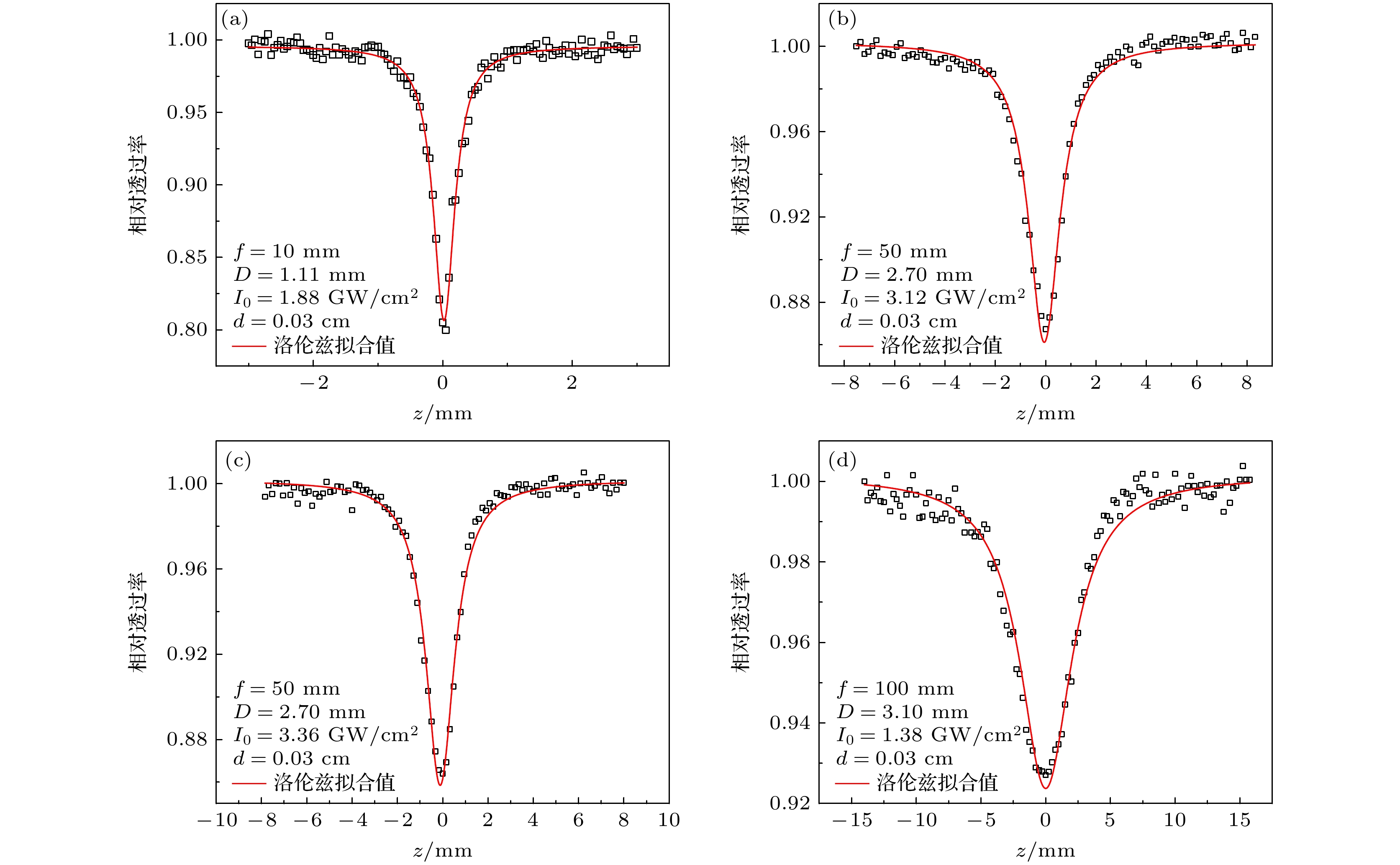-
With the development of technology, ultrafast pulse lasers are increasingly used in many fields, such as material processing, imaging, and medical treatments. The precision of these applications often depends on the ability to focus the laser beam into a tight spot with a minimal divergence in a certain range along the optical axis. Therefore, accurate measurement of depth of focus (DOF) is crucial for optimizing the performance of ultrafast laser systems and ensuring the reliability of the results obtained in various experiments and applications. Traditional methods of measuring the DOF mainly rely on directly capturing the beam size, which is impractical in high-intensity environments of ultrafast pulse laser systems due to potential damage to sensors and limitations in measurement accuracy. Furthermore, using autocorrelation or moving sensors to measure DOF in ultrafast pulse lasers introduces complex optical paths, leading to measurement errors and making them unreliable in precise focusing applications. To solve the problem of the limitations of current DOF measurement techniques for ultrafast pulse laser, in this work we propose a novel method based on Z-scan technique. According to nonlinear optical theory, it is found that the transmittance curves obtained from open-aperture (OA) Z-scan measurements of samples exhibiting two-photon absorption (TPA) all follow a Lorentzian distribution. By fitting this curve by Lorentzian distribution, the DOF of ultrafast pulse lasers and the full widths at half maximum (FWHM) of the OA Z-scan curves can be determined rapidly. The transmittance curves of solid and liquid samples with TPA across different types of lenses and microscope objectives within ultrafast optical systems are measured. The results show that the FWHM of the OA Z-scan curves and the theoretical DOF values are well consistent. This method effectively relates the size of the DOF to the beam waist radius derived from the distribution of the Lorentzian function in the OA Z-scan experimental curves, eliminating the influence of other parameters on the measurement results. In conclusion, a novel method of measuring DOF in ultrafast pulse laser systems by using the OA Z-scan technique is proposed. It provides a rapid, accurate and reliable way for determining the DOF in ultrafast laser focusing systems, thereby precisely controlling the ultrafast laser beam for a wide range of applications. -
Keywords:
- Z-scan /
- two-photon absorption /
- depth of focus /
- Lorentzian distribution
[1] Chen B Y, Chakraborty T, Daetwyler S, Manton J D, Dean K, Fiolka R 2020 Biomed. Opt. Express 11 3830
 Google Scholar
Google Scholar
[2] Bo E, Luo Y M, Chen S, Liu X Y, Wang N S, Ge X, Wang X H, Chen S F, Chen S, Li J H, Liu L B 2017 Optica 4 701
 Google Scholar
Google Scholar
[3] 刘有海, 秦天翔, 王英策, 亢兴旺, 刘君, 吴佳琛, 曹良才 2023 72 084205
 Google Scholar
Google Scholar
Liu Y H, Qin T X, Wang Y C, Kang X W, Liu J, Wu J C, Cao L C 2023 Acta Phys. Sin. 72 084205
 Google Scholar
Google Scholar
[4] 王华英, 张志会, 廖薇, 宋修法, 郭中甲, 刘飞飞 2012 61 044208
 Google Scholar
Google Scholar
Wang H Y, Zhang Z H, Liao W, Song X F, Guo Z J, Liu F F 2012 Acta Phys. Sin. 61 044208
 Google Scholar
Google Scholar
[5] 韦芊屹, 倪洁蕾, 李灵, 张聿全, 袁小聪, 闵长俊 2023 72 178701
 Google Scholar
Google Scholar
Wei Q Y, Ni J L, Li L, Zhang Y Q, Yuan X C, Min C J 2023 Acta Phys. Sin. 72 178701
 Google Scholar
Google Scholar
[6] Adachi S, Ishii H, Kanai T, Ishii N, Kosuge A, Watanabe S 2007 Opt. Lett. 32 2487
 Google Scholar
Google Scholar
[7] Cheng J, Liu C S, Shang S, Liu D, Perrie W, Dearden G, Watkins K 2013 Opt. Laser Technol. 46 88
 Google Scholar
Google Scholar
[8] Guo B S, Sun J Y, Lu Y F, Jiang L 2019 Int. J. Extreme Manuf. 1 032004
 Google Scholar
Google Scholar
[9] Gattass R R, Mazur E 2008 Nat. Photonics 2 219
 Google Scholar
Google Scholar
[10] Kravtsov V, Ulbricht R, Atkin J M, Raschke M B 2016 Nat. Nanotechnol. 11 459
 Google Scholar
Google Scholar
[11] Kumar R S S, Rao S V, Giribabu L, Rao D N 2007 Chem. Phys. Lett. 447 274
 Google Scholar
Google Scholar
[12] Bindra K S, Kar A K 2001 Appl. Phys. Lett. 79 3761
 Google Scholar
Google Scholar
[13] Krausz F, Ivanov M 2009 Rev. Mod. Phys. 81 163
 Google Scholar
Google Scholar
[14] Tang H C, Men T, Liu X L, Hu Y D, Su J Q, Zuo Y L, Li P, Liang J Y, Downer M C, Li Z Y 2022 Light Sci. Appl. 11 244
 Google Scholar
Google Scholar
[15] Castro-Marín P, Castro-Olvera G, Garduño-Mejia J, Rosete-Aguilar M, Bruce N C, Reid D T, Rodríguez-Herrera O G 2017 Opt. Express 25 14473
 Google Scholar
Google Scholar
[16] Ramírez-Guerra C, Rosete-Aguilar M, Garduño-Mejía J 2020 Appl. Opt. 59 1519
 Google Scholar
Google Scholar
[17] Castro-Marín P, Castro-Olvera G, Ruíz C, Garduño-Mejía J, Rosete-Aguilar M, Bruce N C 2017 AIP Adv. 7 105014
 Google Scholar
Google Scholar
[18] Fan Z B, Qiu H Y, Zhang H L, Pang X N, Zhou L D, Liu L, Ren H, Wang Q H, Dong J W 2019 Light Sci. Appl. 8 67
 Google Scholar
Google Scholar
[19] Flores A, Wang M R, Yang J J 2004 Appl. Opt. 43 5618
 Google Scholar
Google Scholar
[20] Wang Z W, Li Q, Yan F 2021 J. Phys. D: Appl. Phys. 54 085103
 Google Scholar
Google Scholar
[21] Vázquez-Villa A, Delgado-Atencio J A, Vázquez-Montiel S, Castro-Ramos J, Cunill-Rodríguez M 2015 Opt. Lett. 40 2842
 Google Scholar
Google Scholar
[22] Aydin T, Akgul Y S 2010 Opt. Express 18 14212
 Google Scholar
Google Scholar
[23] Banerji S, Meem M, Majumder A, Sensale-Rodriguez B, Menon R 2020 Optica 7 214
 Google Scholar
Google Scholar
[24] Moreno-Larios J A, Rosete-Aguilar M, Rodríguez-Herrera O G, Garduño-Mejía J 2020 Appl. Opt. 59 7247
 Google Scholar
Google Scholar
[25] Sheik-bahae M, Said A A, Wei T H, Wu Y Y, Hagan D J, Soileau M J, Stryland E W V 1990 Proc. SPIE Int. Soc. Opt. Eng. 1148 41
 Google Scholar
Google Scholar
[26] Sheik-Bahae M, Said A A, Wei T H, Hagan D J, Van Stryland E W 1990 IEEE J. Quantum Electron. 26 760
 Google Scholar
Google Scholar
[27] Yin M, Li H P, Tang S H, Ji W 2000 Appl. Phys. B 70 587
 Google Scholar
Google Scholar
-
图 2 在(a)低光强和(b)高光强条件下, 开孔Z扫描计算公式前m项近似仿真的透射率分布曲线以及洛伦兹函数拟合; 取m = 3时, 理论模拟的不同(c)样品厚度、(d)非线性吸收系数下的透射率分布曲线. 插图为相应的归一化透射率分布
Figure 2. Under conditions of (a) low laser intensity and (b) high laser intensity, the simulated transmittance distribution curves for the first m terms of the open-aperture Z-scan calculation formula, and the Lorentzian function fits; simulated transmittance distributions for varying (c) sample thicknesses and (d) nonlinear absorption coefficients when m = 3. The insets show the corresponding normalized transmittance distributions.
图 7 开孔Z扫描结果以及对应的洛伦兹拟合曲线 (a) 20倍消色差显微物镜(焦距10 mm); (b)平凸透镜(焦距50 mm); (c)消色差透镜(焦距50 mm); (d)平凸透镜(焦距100 mm)
Figure 7. Open-aperture Z-scan results and their Lorentzian fit results: (a) 20× apochromatic microscope objective lens (f = 10 mm); (b) planoconvex lens (f = 50 mm); (c) achromatic lens (f = 50 mm); (d) plano-convex lens (f = 100 mm).
-
[1] Chen B Y, Chakraborty T, Daetwyler S, Manton J D, Dean K, Fiolka R 2020 Biomed. Opt. Express 11 3830
 Google Scholar
Google Scholar
[2] Bo E, Luo Y M, Chen S, Liu X Y, Wang N S, Ge X, Wang X H, Chen S F, Chen S, Li J H, Liu L B 2017 Optica 4 701
 Google Scholar
Google Scholar
[3] 刘有海, 秦天翔, 王英策, 亢兴旺, 刘君, 吴佳琛, 曹良才 2023 72 084205
 Google Scholar
Google Scholar
Liu Y H, Qin T X, Wang Y C, Kang X W, Liu J, Wu J C, Cao L C 2023 Acta Phys. Sin. 72 084205
 Google Scholar
Google Scholar
[4] 王华英, 张志会, 廖薇, 宋修法, 郭中甲, 刘飞飞 2012 61 044208
 Google Scholar
Google Scholar
Wang H Y, Zhang Z H, Liao W, Song X F, Guo Z J, Liu F F 2012 Acta Phys. Sin. 61 044208
 Google Scholar
Google Scholar
[5] 韦芊屹, 倪洁蕾, 李灵, 张聿全, 袁小聪, 闵长俊 2023 72 178701
 Google Scholar
Google Scholar
Wei Q Y, Ni J L, Li L, Zhang Y Q, Yuan X C, Min C J 2023 Acta Phys. Sin. 72 178701
 Google Scholar
Google Scholar
[6] Adachi S, Ishii H, Kanai T, Ishii N, Kosuge A, Watanabe S 2007 Opt. Lett. 32 2487
 Google Scholar
Google Scholar
[7] Cheng J, Liu C S, Shang S, Liu D, Perrie W, Dearden G, Watkins K 2013 Opt. Laser Technol. 46 88
 Google Scholar
Google Scholar
[8] Guo B S, Sun J Y, Lu Y F, Jiang L 2019 Int. J. Extreme Manuf. 1 032004
 Google Scholar
Google Scholar
[9] Gattass R R, Mazur E 2008 Nat. Photonics 2 219
 Google Scholar
Google Scholar
[10] Kravtsov V, Ulbricht R, Atkin J M, Raschke M B 2016 Nat. Nanotechnol. 11 459
 Google Scholar
Google Scholar
[11] Kumar R S S, Rao S V, Giribabu L, Rao D N 2007 Chem. Phys. Lett. 447 274
 Google Scholar
Google Scholar
[12] Bindra K S, Kar A K 2001 Appl. Phys. Lett. 79 3761
 Google Scholar
Google Scholar
[13] Krausz F, Ivanov M 2009 Rev. Mod. Phys. 81 163
 Google Scholar
Google Scholar
[14] Tang H C, Men T, Liu X L, Hu Y D, Su J Q, Zuo Y L, Li P, Liang J Y, Downer M C, Li Z Y 2022 Light Sci. Appl. 11 244
 Google Scholar
Google Scholar
[15] Castro-Marín P, Castro-Olvera G, Garduño-Mejia J, Rosete-Aguilar M, Bruce N C, Reid D T, Rodríguez-Herrera O G 2017 Opt. Express 25 14473
 Google Scholar
Google Scholar
[16] Ramírez-Guerra C, Rosete-Aguilar M, Garduño-Mejía J 2020 Appl. Opt. 59 1519
 Google Scholar
Google Scholar
[17] Castro-Marín P, Castro-Olvera G, Ruíz C, Garduño-Mejía J, Rosete-Aguilar M, Bruce N C 2017 AIP Adv. 7 105014
 Google Scholar
Google Scholar
[18] Fan Z B, Qiu H Y, Zhang H L, Pang X N, Zhou L D, Liu L, Ren H, Wang Q H, Dong J W 2019 Light Sci. Appl. 8 67
 Google Scholar
Google Scholar
[19] Flores A, Wang M R, Yang J J 2004 Appl. Opt. 43 5618
 Google Scholar
Google Scholar
[20] Wang Z W, Li Q, Yan F 2021 J. Phys. D: Appl. Phys. 54 085103
 Google Scholar
Google Scholar
[21] Vázquez-Villa A, Delgado-Atencio J A, Vázquez-Montiel S, Castro-Ramos J, Cunill-Rodríguez M 2015 Opt. Lett. 40 2842
 Google Scholar
Google Scholar
[22] Aydin T, Akgul Y S 2010 Opt. Express 18 14212
 Google Scholar
Google Scholar
[23] Banerji S, Meem M, Majumder A, Sensale-Rodriguez B, Menon R 2020 Optica 7 214
 Google Scholar
Google Scholar
[24] Moreno-Larios J A, Rosete-Aguilar M, Rodríguez-Herrera O G, Garduño-Mejía J 2020 Appl. Opt. 59 7247
 Google Scholar
Google Scholar
[25] Sheik-bahae M, Said A A, Wei T H, Wu Y Y, Hagan D J, Soileau M J, Stryland E W V 1990 Proc. SPIE Int. Soc. Opt. Eng. 1148 41
 Google Scholar
Google Scholar
[26] Sheik-Bahae M, Said A A, Wei T H, Hagan D J, Van Stryland E W 1990 IEEE J. Quantum Electron. 26 760
 Google Scholar
Google Scholar
[27] Yin M, Li H P, Tang S H, Ji W 2000 Appl. Phys. B 70 587
 Google Scholar
Google Scholar
Catalog
Metrics
- Abstract views: 2007
- PDF Downloads: 52
- Cited By: 0
















 DownLoad:
DownLoad:






